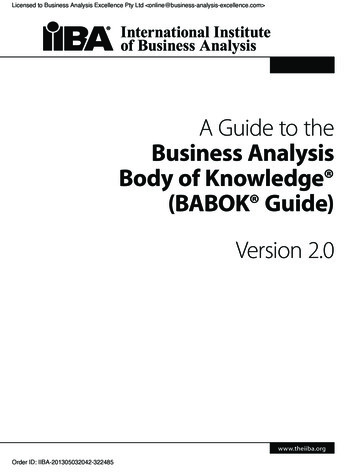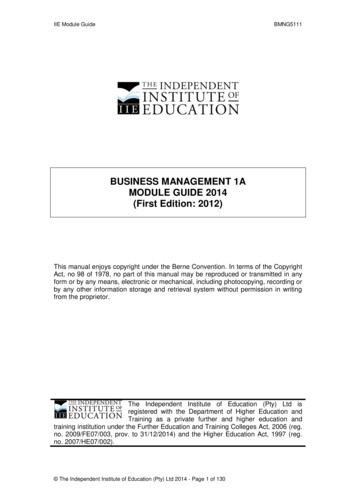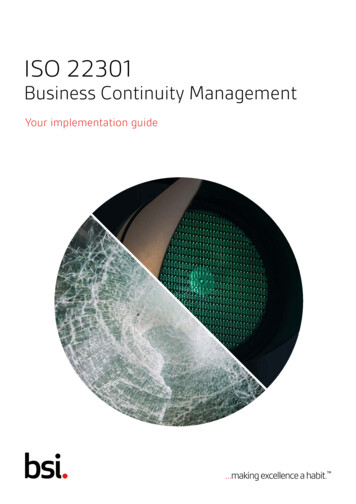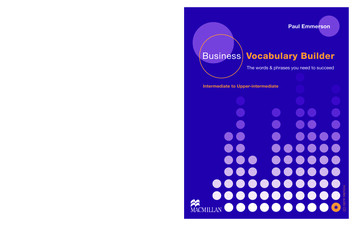
Transcription
Licensed to Business Analysis Excellence Pty Ltd online@business-analysis-excellence.com A Guide to theBusiness AnalysisBody of Knowledge (BABOK Guide)Version 2.0www.theiiba.orgOrder ID: IIBA-201305032042-322485
Licensed to Business Analysis Excellence Pty Ltd online@business-analysis-excellence.com International Institute of Business Analysis, Toronto, Ontario, Canada. 2005, 2006, 2008, 2009, International Institute of Business Analysis. All rights reserved.Portions of Appendix A: Glossary are from The Software Requirements Memory Jogger, by EllenGottesdiener, 2005 GOAL/QPC and are used with permission.Cover Image 2006 iStockphoto.com/Damkier Media Group.Version 1.0 and 1.4 published 2005. Version 1.6 Draft published 2006. Version 1.6 Final published 2008.Version 2.0 published 2009. Second Printing.ISBN-13: 978-0-9811292-1-1 (print)ISBN-13: 978-0-9811292-2-8 (PDF and EBook)Permisson is granted to reproduce this document for your own personal, professional, or educationaluse. If you have purchased a license to use this document from IIBA , you may transfer ownership to athird party. IIBA Members may not transfer ownership of their complimentary copy.This document is provided to the business analysis community for educational purposes. IIBA doesnot warrant that it is suitable for any other purpose and makes no expressed or implied warranty ofany kind and assumes no responsibility for errors or omissions. No liability is assumed for incidentalor consequential damages in connection with or arising out of the use of the information containedherein.IIBA , the IIBA logo, BABOK and Business Analysis Body of Knowledge are registered trademarksowned by International Institute of Business Analysis. CBAP is a registered certification mark ownedby International Institute of Business Analysis. Certified Business Analysis Professional, EEP and theEEP logo are trademarks owned by International Institute of Business Analysis.CMMI is a registered trademark of Carnegie Mellon University.COBIT is a trademark of the Information Systems Audit and Control Association and the ITGovernance Institute.ITIL is a registered trademark of the Office of Government Commerce in the United Kingdom andother countries.TOGAF is a trademark of The Open Group in the US and other countries.Zachman Framework for Enterprise Architecture is a trademark of the Zachman Institute forFramework Advancement.No challenge to the status or ownership of these or any other trademarked terms contained herein isintended by the International Institute of Business Analysis.Any inquiries regarding this publication, requests for usage rights for the material included herein, orcorrections should be sent by email to bok@theiiba.org.Order ID: IIBA-201305032042-322485
Licensed to Business Analysis Excellence Pty Ltd online@business-analysis-excellence.com Table of ContentsPreface1Chapter 1: Introduction31.11.21.31.41.51.61.71.8What is the Business Analysis Body of Knowledge?What is Business Analysis?Key ConceptsKnowledge AreasTasksTechniquesUnderlying CompetenciesOther Sources of Business Analysis Information33468131515Chapter 2: Business Analysis Planning & Monitoring172.12.22.32.42.52.6172431374249Plan Business Analysis ApproachConduct Stakeholder AnalysisPlan Business Analysis ActivitiesPlan Business Analysis CommunicationPlan Requirements Management ProcessManage Business Analysis PerformanceChapter 3: Elicitation533.13.23.33.454565961Prepare for ElicitationConduct Elicitation ActivityDocument Elicitation ResultsConfirm Elicitation ResultsChapter 4: Requirements Management & Communication634.14.24.34.44.56367707277Manage Solution Scope & RequirementsManage Requirements TraceabilityMaintain Requirements for Re-usePrepare Requirements PackageCommunicate RequirementsChapter 5: Enterprise Analysis815.15.25.35.45.58185889194Define Business NeedAssess Capability GapsDetermine Solution ApproachDefine Solution ScopeDefine Business CaseBABOK Guide, Version 2.0Order ID: IIBA-201305032042-322485iii
Licensed to Business Analysis Excellence Pty Ltd online@business-analysis-excellence.com Table of ContentsChapter 6: Requirements Analysis6.16.26.36.46.56.6Prioritize RequirementsOrganize RequirementsSpecify and Model RequirementsDefine Assumptions and ConstraintsVerify RequirementsValidate Requirements9999103107111114117Chapter 7: Solution Assessment & ssess Proposed SolutionAllocate RequirementsAssess Organizational ReadinessDefine Transition RequirementsValidate SolutionEvaluate Solution PerformanceChapter 8: Underlying 2Analytical Thinking and Problem SolvingBehavioral CharacteristicsBusiness KnowledgeCommunication SkillsInteraction SkillsSoftware ApplicationsChapter 9: 70172174176177181182184Acceptance and Evaluation Criteria DefinitionBenchmarkingBrainstormingBusiness Rules AnalysisData Dictionary and GlossaryData Flow DiagramsData ModelingDecision AnalysisDocument AnalysisEstimationFocus GroupsFunctional DecompositionInterface AnalysisInterviewsLessons Learned ProcessMetrics and Key Performance IndicatorsNon-functional Requirements AnalysisivOrder ID: IIBA-201305032042-322485A Guide to the Business Analysis Body of Knowledge
Licensed to Business Analysis Excellence Pty Ltd online@business-analysis-excellence.com Table of 289.299.309.319.329.339.34ObservationOrganization ModelingProblem TrackingProcess ModelingPrototypingRequirements WorkshopsRisk AnalysisRoot Cause AnalysisScenarios and Use CasesScope ModelingSequence DiagramsState DiagramsStructured WalkthroughSurvey/QuestionnaireSWOT AnalysisUser StoriesVendor 14217219220Appendix A: Glossary223Appendix B: Bibliography237Appendix C: Contributors243C.1C.2243245Version 2.0Version 1.6Appendix D: Summary of Changes from Version 1251OverviewEnterprise AnalysisRequirements Planning and ManagementRequirements ElicitationRequirements Analysis and DocumentationRequirements CommunicationSolution Assessment and ValidationUnderlying FundamentalsAppendix E: IndexBABOK Guide, Version 2.0Order ID: IIBA-201305032042-322485253v
Licensed to Business Analysis Excellence Pty Ltd online@business-analysis-excellence.com Order ID: IIBA-201305032042-322485
Licensed to Business Analysis Excellence Pty Ltd online@business-analysis-excellence.com PrefaceIIBA was founded in Toronto, Canada in October of 2003 to support the business analysiscommunity by: Creating and developing awareness and recognition of the value and contribution ofthe Business Analyst. Defining the Business Analysis Body of Knowledge (BABOK ). Providing a forum for knowledge sharing and contribution to the business analysisprofession. Publicly recognizing and certifying qualified practitioners through an internationallyacknowledged certification program.The Body of Knowledge Committee was formed in October of 2004 to define and draft aglobal standard for the practice of business analysis. In January of 2005, IIBA releasedversion 1.0 of A Guide to the Business Analysis Body of Knowledge (BABOK Guide) forfeedback and comment. That version included an outline of the proposed content andsome key definitions. Version 1.4 was released in October of 2005, with draft contentin some knowledge areas. Version 1.6, which included detailed information regardingmost of the knowledge areas, was published in draft form in June of 2006 and updated toincorporate errata in October of 2008.This publication supersedes A Guide to the Business Analysis Body of Knowledge , Version1.6. Following the publication of version 1.6, IIBA sought out a number of recognizedexperts in business analysis and related fields and solicited their feedback on thecontent of that edition. Their comments were used to plan the scope of this revision.IIBA volunteers then worked to define a structure for version 2.0 and developed therevised text, which was made available to the business analysis community for review in2008. During that exposure period, IIBA also solicited feedback from industry expertsand business analysis practitioners through a formal review process. IIBA receivedthousands of comments during this process, and this document has been revised toincorporate as many of those comments as possible.The BABOK Guide contains a description of generally accepted practices in the field ofbusiness analysis. The content included in this release has been verified through reviewsby practitioners, surveys of the business analysis community, and consultations withrecognized experts in the field. The data available to IIBA demonstrate that the tasksand techniques described in this publication are in use by a majority of business analysispractitioners. As a result, we can have confidence that the tasks and techniques describedin the BABOK Guide should be applicable in most contexts where business analysis isperformed, most of the time.The BABOK Guide should not be construed to mandate that the practices described inthis publication should be followed under all circumstances. Any set of practices must betailored to the specific conditions under which business analysis is being performed. Inaddition, practices which are not generally accepted by the business analysis communityat the time of publication may be equally effective, or more effective, than the practicesBABOK Guide, Version 2.0Order ID: IIBA-201305032042-3224851
Licensed to Business Analysis Excellence Pty Ltd online@business-analysis-excellence.com Prefacedescribed in the BABOK Guide. As such practices become generally accepted, and as datais collected to verify their effectiveness, they will be incorporated into future editions ofthis publication. IIBA encourages all practitioners of business analysis to be open tonew approaches and new ideas, and wishes to encourage innovation in the practice ofbusiness analysis.The goal of this revision was to: Complete the description of all knowledge areas. Simplify the structure to make it easier to understand and apply. Improve the consistency and quality of text and illustrations. Integrate the knowledge areas and eliminate areas of overlap. Improve consistency with other generally accepted standards relating to the practiceof business analysis. Extend the coverage of the BABOK Guide to describe business analysis in contextsbeyond traditional approaches to custom software application development,including but not limited to agile methodologies, Business Process Management,and commercial-off-the-shelf (COTS) application assessment and implementation. Clarify the relationship between business analysis and other disciplines, particularlyproject management, testing, and usability and information architecture. Focus on the practice of business analysis in the context of the individual initiative,with material on strategic or enterprise-wide business analysis separated forinclusion in a future application extension.The major changes in this release include: Changes throughout to address the goals described above. All content has been revised and edited, and much of it has been rewritten. Many of the tasks found in version 1.6 have been consolidated, resulting in a reductionfrom 77 tasks to 32. Tasks in the Requirements Planning and Management Knowledge Area havebeen reallocated to Business Analysis Planning and Monitoring and RequirementsManagement and Communication. Three other knowledge areas have been renamed to better reflect their purpose. Techniques apply across multiple Knowledge Areas. Inputs and Outputs have been defined for all tasks.IIBA would like to extend its thanks and the thanks of the business analysis communityto all those who volunteered their time and effort to the development of this revision, aswell as those who provided informal feedback to us in other ways.2Order ID: IIBA-201305032042-322485A Guide to the Business Analysis Body of Knowledge
Licensed to Business Analysis Excellence Pty Ltd online@business-analysis-excellence.com Introductionchapter1.1ONEWhat is the Business Analysis Body of Knowledge?A Guide to the Business Analysis Body of Knowledge (BABOK Guide) is a globallyrecognized standard for the practice of business analysis. The BABOK Guide describesbusiness analysis areas of knowledge, their associated activities and tasks, and the skillsnecessary to be effective in their execution.The primary purpose of the BABOK Guide is to define the profession of business analysis.It serves as a baseline that practitioners can agree upon in order to discuss the work theydo and to ensure that they have the skills they need to effectively perform the role, anddefines the skills and knowledge that people who work with and employ business analystsshould expect a skilled practitioner to demonstrate. It is a framework that describes thebusiness analysis tasks that must be performed in order to understand how a solutionwill deliver value to the sponsoring organization. The form those tasks take, the orderthey are performed in, the relative importance of the tasks, and other things may vary,but each task contributes in some fashion, directly or indirectly, to that overall goal.This chapter provides an introduction to key concepts in the field of business analysisand describes the structure of the remainder of the BABOK Guide. Chapters 2 through7 define the tasks that a business analyst must be capable of performing. Chapter 8describes the competencies that support the effective performance of business analysis,and Chapter 9 describes a number of generally accepted techniques that support thepractice of business analysis.1.2What is Business Analysis?Business analysis is the set of tasks and techniques used to work as a liaison amongstakeholders in order to understand the structure, policies, and operations of anorganization, and to recommend solutions that enable the organization to achieve itsgoals.Business analysis involves understanding how organizations function to accomplishtheir purposes, and defining the capabilities an organization requires to provide productsand services to external stakeholders. It includes the definition of organizational goals,how those goals connect to specific objectives, determining the courses of action thatan organization has to undertake to achieve those goals and objectives, and defininghow the various organizational units and stakeholders within and outside of thatorganization interact.Business analysis may be performed to understand the current state of an organization orto serve as a basis for the later identification of business needs. In most cases, however,business analysis is performed to define and validate solutions that meet business needs,goals, or objectives.Business analysts must analyze and synthesize information provided by a large numberof people who interact with the business, such as customers, staff, IT professionals,and executives. The business analyst is responsible for eliciting the actual needs ofstakeholders, not simply their expressed desires. In many cases, the business analystBABOK Guide, Version 2.0Order ID: IIBA-201305032042-3224853
Licensed to Business Analysis Excellence Pty Ltd online@business-analysis-excellence.com IntroductionKey Conceptswill also work to facilitate communication between organizational units. In particular,business analysts often play a central role in aligning the needs of business units withthe capabilities delivered by information technology, and may serve as a “translator”between those groups.A business analyst is any person who performs business analysis activities, no matterwhat their job title or organizational role may be. Business analysis practitioners includenot only people with the job title of business analyst, but may also include businesssystems analysts, systems analysts, requirements engineers, process analysts, productmanagers, product owners, enterprise analysts, business architects, managementconsultants, or any other person who performs the tasks described in the BABOK Guide,including those who also perform related disciplines such as project management,software development, quality assurance, and interaction design.1.3Key Concepts1.3.1DomainsA domain is the area undergoing analysis. It may correspond to the boundaries of anorganization or organizational unit, as well as key stakeholders outside those boundariesand interactions with those stakeholders.1.3.2SolutionsA solution is a set of changes to the current state of an organization that are made in orderto enable that organization to meet a business need, solve a problem, or take advantageof an opportunity. The scope of the solution is usually narrower than the scope of thedomain within which it is implemented, and will serve as the basis for the scope of aproject to implement that solution or its components.Most solutions are a system of interacting solution components, each of which arepotentially solutions in their own right. Examples of solutions and solution componentsinclude software applications, web services, business processes, the business rules thatgovern that process, an information technology application, a revised organizationalstructure, outsourcing, insourcing, redefining job roles, or any other method of creatinga capability needed by an organization.Business analysis helps organizations define the optimal solution for their needs, giventhe set of constraints (including time, budget, regulations, and others) under which thatorganization operates.1.3.3RequirementsA requirement1 is:1. A condition or capability needed by a stakeholder to solve a problem or achieve anobjective.2. A condition or capability that must be met or possessed by a solution or solutioncomponent to satisfy a contract, standard, specification, or other formally imposeddocuments.1Based on IEEE 610.12-1990: IEEE Standard Glossary of Software Engineering Terminology.4Order ID: IIBA-201305032042-322485A Guide to the Business Analysis Body of Knowledge
Licensed to Business Analysis Excellence Pty Ltd online@business-analysis-excellence.com IntroductionKey Concepts3. A documented representation of a condition or capability as in (1) or (2).As implied by this definition, a requirement may be unstated, implied by or derivedfrom other requirements, or directly stated and managed. One of the key objectives ofbusiness analysis is to ensure that requirements are visible to and understood by allstakeholders.The term “requirement” is one that generates a lot of discussion within the businessanalysis community. Many of these debates focus on what should or should not beconsidered a requirement, and what are the necessary characteristics of a requirement.When reading the BABOK Guide, however, it is vital that “requirement” be understood inthe broadest possible sense. Requirements include, but are not limited to, past, present,and future conditions or capabilities in an enterprise and descriptions of organizationalstructures, roles, processes, policies, rules, and information systems. A requirement maydescribe the current or the future state of any aspect of the enterprise.Much of the existing literature on business analysis is written with the assumption thatrequirements only describe an information technology system that is being consideredfor implementation. Other definitions may include future state business functions aswell, or restrict the meaning of the term to define the ends stakeholders are seeking toachieve and not the means by which those ends are achieved. While all of these differentuses of the term are reasonable and defensible, and the BABOK Guide’s usage of the termincludes those meanings, they are significantly narrower than the way the term is usedhere.Similarly, we do not assume that requirements are analyzed at any particular levelof detail, other than to say that they should be assessed to whatever level of depth isnecessary for understanding and action. In the context of a Business Process Managementinitiative, the requirements may be a description of the business processes currently inuse in an organization. On other projects, the business analyst may choose to developrequirements to describe the current state of the enterprise (which is in itself a solutionto existing or past business needs) before investigating changes to that solution neededto meet changing business conditions.1Requirements Classification SchemeFor the purposes of the BABOK Guide, the following classification scheme is used todescribe requirements: Business Requirements are higher-level statements of the goals, objectives, orneeds of the enterprise. They describe the reasons why a project has been initiated,the objectives that the project will achieve, and the metrics that will be used tomeasure its success. Business requirements describe needs of the organization asa whole, and not groups or stakeholders within it. They are developed and definedthrough enterprise analysis. Stakeholder Requirements are statements of the needs of a particular stakeholderor class of stakeholders. They describe the needs that a given stakeholder has andhow that stakeholder will interact with a solution. Stakeholder requirements serveas a bridge between business requirements and the various classes of solutionrequirements. They are developed and defined through requirements analysis.BABOK Guide, Version 2.0Order ID: IIBA-201305032042-3224855
Licensed to Business Analysis Excellence Pty Ltd online@business-analysis-excellence.com IntroductionKnowledge Areas Solution Requirements describe the characteristics of a solution that meet businessrequirements and stakeholder requirements. They are developed and defined throughrequirements analysis. They are frequently divided into sub-categories, particularlywhen the requirements describe a software solution: Functional Requirements describe the behavior and information that thesolution will manage. They describe capabilities the system will be able toperform in terms of behaviors or operations—specific information technologyapplication actions or responses. Non-functional Requirements capture conditions that do not directly relate tothe behavior or functionality of the solution, but rather describe environmentalconditions under which the solution must remain effective or qualities thatthe systems must have. They are also known as quality or supplementaryrequirements. These can include requirements related to capacity, speed,security, availability and the information architecture and presentation of theuser interface. Transition Requirements describe capabilities that the solution must have inorder to facilitate transition from the current state of the enterprise to a desiredfuture state, but that will not be needed once that transition is complete. They aredifferentiated from other requirements types because they are always temporary innature and because they cannot be developed until both an existing and new solutionare defined. They typically cover data conversion from existing systems, skill gapsthat must be addressed, and other related changes to reach the desired future state.They are developed and defined through solution assessment and validation.1.4Knowledge AreasKnowledge areas define what a practitioner of business analysis needs to understandand the tasks a practitioner must be able to perform.Business analysts are likely to perform tasks from all knowledge areas in rapidsuccession, iteratively, or simultaneously. Tasks may be performed in any order as longas the required inputs are available. In principle, a business analysis effort may start withany task, although the most likely candidates are Define Business Need (5.1) or EvaluateSolution Performance (7.6).Knowledge areas are not intended to represent phases in a project. It is certainlypossible and permissible to proceed from performing enterprise analysis activities, torequirements analysis activities, to solution assessment and validation activities, andtreat each as a distinct phase in a project. However, the BABOK Guide does not requirethat you do so, and it should not be construed as a methodology for the performance ofbusiness analysis.Business Analysis Planning and Monitoring (Chapter 2) is the knowledge area thatcovers how business analysts determine which activities are necessary in order tocomplete a business analysis effort. It covers identification of stakeholders, selectionof business analysis techniques, the process that will be used to manage requirements,and how to assess the progress of the work. The tasks in this knowledge area govern theperformance of all other business analysis tasks.6Order ID: IIBA-201305032042-322485A Guide to the Business Analysis Body of Knowledge
Licensed to Business Analysis Excellence Pty Ltd online@business-analysis-excellence.com IntroductionKnowledge AreasElicitation (Chapter 3) describes how business analysts work with stakeholders toidentify and understand their needs and concerns, and understand the environmentin which they work. The purpose of elicitation is to ensure that a stakeholder’s actualunderlying needs are understood, rather than their stated or superficial desires.Requirements Management and Communication (Chapter 4) describes how businessanalysts manage conflicts, issues and changes in order to ensure that stakeholders andthe project team remain in agreement on the solution scope, how requirements arecommunicated to stakeholders, and how knowledge gained by the business analyst ismaintained for future use.Enterprise Analysis (Chapter 5) describes how business analysts identify a businessneed, refine and clarify the definition of that need, and define a solution scope thatcan feasibly be implemented by the business. This knowledge area describes problemdefinition and analysis, business case development, feasibility studies, and the definitionof solution scope.Requirements Analysis (Chapter 6) describes how business analysts prioritize andprogressively elaborate stakeholder and solution requirements in order to enablethe project team to implement a solution that will meet the needs of the sponsoringorganization and stakeholders. It involves analyzing stakeholder needs to definesolutions that meet those needs, assessing the current state of the business to identifyand recommend improvements, and the verification and validation of the resultingrequirements.Figure 1–1: Relationships Between Knowledge AreasBusiness AnalysisPlanning andMonitoringSolutionAssessment entsManagement etenciesBABOK Guide, Version 2.0Order ID: IIBA-201305032042-3224857
Licensed to Business Analysis Excellence Pty Ltd online@business-analysis-excellence.com IntroductionTasksSolution Assessment and Validation (Chapter 7) describes how business analysts assessproposed solutions to determine which solution best fits the business need, identify gapsand shortcomings in solutions, and determine necessary workarounds or changes tothe solution. It also describes how business analysts assess deployed solutions to seehow well they met the original need so that the sponsoring organization can assess theperformance and effectiveness of the solution.Underlying Competencies (Chapter 8) describes the behaviors, knowledge, and othercharacteristics that support the effective performance of business analysis.1.5TasksEach knowledge area describes the tasks performed by business analysts to accomplishthe purpose of that knowledge area. Each task in the BABOK Guide is presented in thefollowing format:1.5.1PurposeEach task has a purpose. The purpose is a short description of the reason for a businessanalyst to perform the task and the value created through performing the task.1.5.2DescriptionA task is an essential piece of work that must be performed as part of business analysis.Each task should be performed at least once during the vast majority of businessanalysis initiatives, but there is no upper limit to the number of times any task may beperformed.Tasks may be performed at any scale. Each task may be performed over periods rangingfrom several months in time to a few minutes. For example, a business case may be adocument several hundred pages long, justifying a multi-billion dollar investment, or asingle sentence explaining the benefit that a change will produce for a single individual.A task has the following characteristics: A task accomplishes a result in an output that creates value to the sponsoringorganization—that is, if a task is performed it should produce some demonstrablepositive outcome which is useful, specific, visible and measurable. A task is complete—in principle, successor tasks that make use of outputs should beable to be performed by a different person or group. A task is a necessary part of the purpose of the Knowledge Area with which it isassociated.The BABOK Guide does not prescribe a process or an order in which tasks are performed.Some ordering of tasks is inevitable, as certain tasks produce outputs that are requiredinputs for other tasks. However, it is important to keep in mind that the BABOK Guideonly prescribes that the input must exist. The input may be incomplete or subject tochange and revision, which may cause the task to be performed multiple times. Iterativeor agile lifecycles may require that tasks in all knowledge areas be performed in parallel,and lifecycles with clearly defined phases will still require tasks from multiple knowledgeareas to be performed in every phase. Tasks may be performed in any order, as long as8Order ID: IIBA-201305032042-322485A Guide to the Business Analysis Body of Knowledge
!e Body of Knowledge Committee was formed in October of 2004 to de"ne and draft a global standard for the practice of business analysis. In January of 2005, IIBA released version 1.0 of A Guide to the Business Analysis Body of Knowledge (BABOK Guide) for feedback and comment. !a











